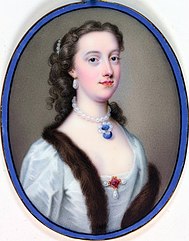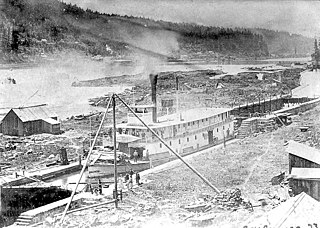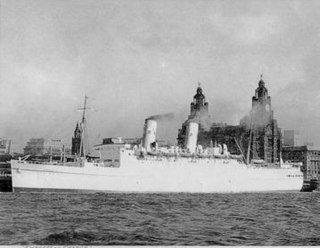
Ceremonial ship launching is the process of transferring a vessel to the water. It is a naval tradition in many cultures, dating back thousands of years. It has been observed as a public celebration and a solemn blessing.

Camilla, Duchess of Cornwall, is a member of the British royal family. She is the second wife of Charles, Prince of Wales, heir apparent to the British throne. Instead of using the title Princess of Wales, she uses the title Duchess of Cornwall, her husband's secondary designation. In Scotland, she is known as the Duchess of Rothesay.

HMAS Duchess was a Daring-class destroyer that served in the Royal Navy as HMS Duchess from 1952 to 1964, and in the Royal Australian Navy (RAN) from 1964 to 1980. She was laid down by John I. Thornycroft and Company, and commissioned into the Royal Navy in 1952.

USS Portland (CL/CA–33) was the lead ship of the Portland class of cruiser and the first ship of the United States Navy named after the city of Portland, Maine. Launched in 1932, she completed a number of training and goodwill cruises in the interwar period before seeing extensive service during World War II, beginning with the Battle of the Coral Sea in 1942, where she escorted the aircraft carrier Yorktown and picked up survivors from the sunken carrier Lexington. She screened for Yorktown again in the Battle of Midway, picking up her survivors as well. She then supported the carrier Enterprise during the initial phase of the Guadalcanal Campaign later that year, and was torpedoed during the Naval Battle of Guadalcanal. The torpedo inflicted heavy damage which put her out of action for six months as she was repaired in Sydney, Australia and later San Diego, California.

The Portland class of heavy cruisers was a class of ships designed and constructed by the United States Navy in 1930. The two ships of the class, Portland and Indianapolis, saw extensive service during the Pacific War in World War II.

Catherine, Duchess of Cambridge, is a member of the British royal family. Her husband, Prince William, Duke of Cambridge, is expected to become king of the United Kingdom and 15 other Commonwealth realms, making Catherine a likely future queen consort.

Margaret Cavendish Bentinck, Duchess of Portland was a British aristocrat, styled Lady Margaret Harley before 1734, Duchess of Portland from 1734 to her husband's death in 1761, and Dowager Duchess of Portland from 1761 until her own death in 1785.

HMS Alexandra was a central battery ironclad of the Victorian Royal Navy, whose seagoing career was from 1877 to 1900. She spent much of her career as a flagship, and took part in operations to deter Russian aggression against Turkey in 1878 and the bombardment of Alexandria in 1882.

SS Duchess of York was a 20,021 ton ocean liner operated by the Canadian Pacific Steamship Company. Built in 1928 in Clydebank by the shipbuilders John Brown & Company, she was originally intended to be named Duchess of Cornwall. However agreement was reached with Red Funnel company to swap names with the latter's paddle steamer Duchess of York, launched in 1896.

HMS Duchess was a D-class destroyer built for the Royal Navy in the early 1930s. The ship was initially assigned to the Mediterranean Fleet before she was transferred to the China Station in early 1935. She was temporarily deployed in the Red Sea during late 1935 during the Abyssinia Crisis, before returning to her duty station where she remained until mid-1939. Duchess was transferred back to the Mediterranean Fleet just before the Second World War began in September 1939. While escorting the battleship HMS Barham back to the British Isles, she was accidentally rammed by the battleship in thick fog and sank with heavy loss of life on 12 December 1939.

The Willamette River flows northwards down the Willamette Valley until it meets the Columbia River at a point 101 miles from the Pacific Ocean, in the U.S. state of Oregon.

Herzogin Cecilie was a German-built four-mast barque (windjammer), named after German Crown Princess Duchess Cecilie of Mecklenburg-Schwerin (1886–1954), spouse of Crown Prince Wilhelm of Prussia (1882–1951). She sailed under German, French and Finnish flags.

The steamship Alaskan operated from 1884 to 1889 on the Columbia River and Puget Sound. Alaskan and her near-sistership Olympian were known as "Henry Villard's White Elephants." There were a number of vessels named Alaska and Alaskan, this large side-wheel steamboat should not be confused with them.

Launched in 1850, Lot Whitcomb, later known as Annie Abernathy, was the first steam-powered craft built on the Willamette River in the U.S. state of Oregon. She was one of the first steam-driven vessels to run on the inland waters of Oregon, and contributed to the rapid economic development of the region.

PS Duchess of Montrose was a paddle steamer launched in 1902 and operated by the Caledonian Steam Packet Company as a River Clyde excursion steamer. She saw active service during the First World War after being requisitioned by the Admiralty and converted into a minesweeper. She was lost near Dunkirk on 18 March 1917 after striking a mine.

RMS Empress of France was an ocean liner built in 1928 by John Brown at Clydebank in the United Kingdom for the Canadian Pacific Steamships and launched as SS Duchess of Bedford in 1928. She was renamed Empress of France in 1947.
Duchess of Norfolk was a 381 GRT paddle steamer built in 1911 for the London, Brighton and South Coast Railway and London and South Western Railway, who operated a joint service to the Isle of Wight. She was requisitioned by the Royal Navy for use as minesweeper HMS Duchess of Norfolk during the First World War, returning to her owners after the war ended. She passed to the Southern Railway on 1 January 1923.

Habib Marikar was a 7,067 GRT cargo ship that was built in 1943 by Short Brothers Ltd, Sunderland, Co Durham as Empire Duchess for the Ministry of War Transport (MoWT). She was sold into merchant service in 1949 and renamed Braemar Castle. A further sale in 1950 saw her renamed King James.
Duchess of Portland was launched at Bristol in 1783. She was primarily a West Indiaman but made one voyage as a slave ship and two as a whaler in the British Southern Whale Fishery. The US Navy captured her in 1812 and burnt her.
Duchess of Portland was launched at Troon in 1826.
















